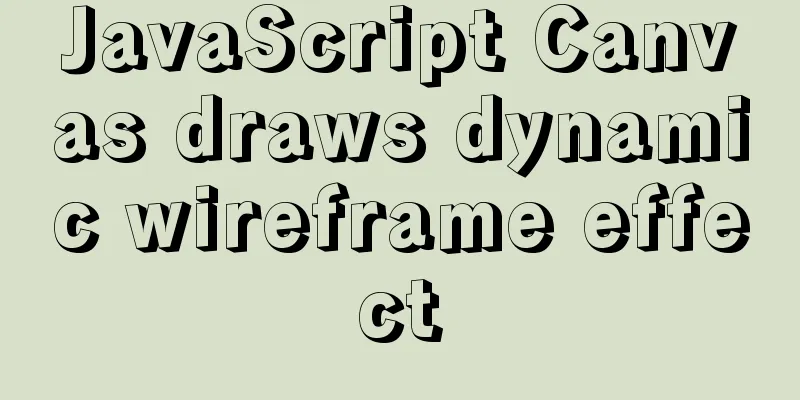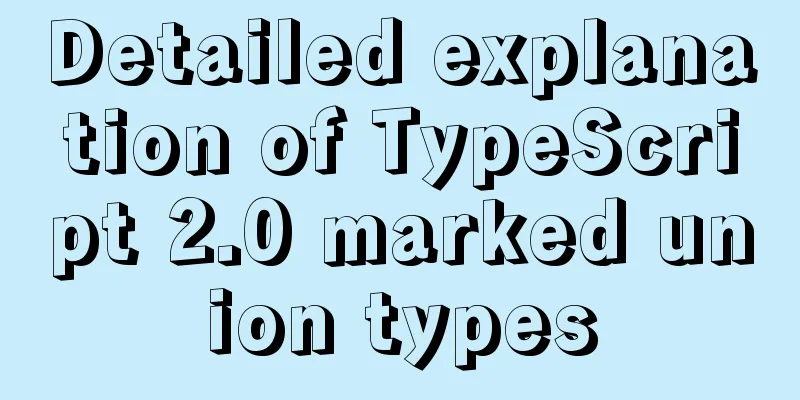JavaScript Canvas draws dynamic wireframe effect

|
This article shares the specific code of JavaScript Canvas drawing dynamic wireframe effect for your reference. The specific content is as follows This week's project is mobile page development, which requires rich dynamic effects. The main technology is Canvas. In drawing the dynamic wireframe, we took a detour. The so-called detour is a logical problem, not a technical implementation method. 1. The technical points involved are as follows: 1. Introduce the canvas tag in html and set the width and height; <canvas id="canvas" width=xx height=xx>Your browser does not support canvas, please change the version</canvas> 2. Define ctx–beginPath–moveTo-lineTo-stroke–closePath in js;
var ctx = canvas.getContext('2d');
ctx.beginPath();
ctx.strokeStyle=#f00;
ctx.lineWidth=1;
ctx.moveTo(x1,y1);
ctx.lineTo(x2,y2);
ctx.lineTo(..)..
ctx.stroke();
ctx.closePath();Drawing a static polyline is relatively simple. It starts from the initial node of moveTo and moves to each node directly. The project requirement is to draw the animation effect of the line. The implementation method is to use the timer to return to the orderly increment points on the lineTo straight line segment from the starting point of moveTo multiple times between each straight line segment. The code is as follows: ctx.moveTo(x1,y3); xm1+=fre1; ym1+=fre2; ctx.lineTo(xm1,ym1) 2. Logical detours and solutions1. Logical detour The project is a mobile terminal. Considering the adaptation problem, when drawing nodes, the product of percentage and the width and height of the screen is used as the true or false judgment of moveTo change; since the product is a non-integer, the incremental change of x and y in the if statement can only use ++; and the increment is in px units, so the drawing speed is very slow, even if the time of setInterval is in milliseconds.
var lg01=ctx.createLinearGradient(0,.12*winH,0,.5*winH);
lg01.addColorStop(0,'#6DEAFF');
lg01.addColorStop(.5,'#78C7FF');
lg01.addColorStop(1,'#4A84FF');
var fre=4;
function drawUpBox(){
ctx.beginPath();
ctx.strokeStyle=lg01;
ctx.lineWidth=0.05*rem;
if(xm1>x2&&ym1==y1){
ctx.clearRect(x2,y1-0.025*rem,x3-x2,0.05*rem);
ctx.moveTo(x3,y1);
xm1-=fre;
ctx.lineTo(xm1,ym1)
}else if(xm1>x1&&ym1<=y2){
ctx.moveTo(x2,y1);
xm1-=fre;
ym1+=fre;
ctx.lineTo(xm1,ym1)
}else if(xm1<=x1&&ym1<y3){
ctx.clearRect(x1-0.025*rem,y2,0.05*rem,y3-y2)
ctx.moveTo(x1,y2);
ym1+=fre;
ctx.lineTo(xm1,ym1)
} else if(ym1<y4){
ctx.moveTo(x1,y3);
xm1+=fre;
ym1+=fre;
ctx.lineTo(xm1,ym1)
}else if(xm1>=x2&&ym1>=y4){
if(xm1<=winW/2){
ctx.clearRect(x1,y4-0.025*rem,winH/2-x1,0.05*rem);
ctx.moveTo(x2,y4)
xm1+=fre;
ctx.lineTo(xm1,ym1)
}
}
if(xm2<x5&&ym2==yd1){
ctx.clearRect(x4,yd1-0.025*rem,x5-x4,0.05*rem);
ctx.moveTo(x4,yd1);
xm2+=fre;
ctx.lineTo(xm2,ym2);
}else if(xm2<x6&&ym1<=yd2){
ctx.moveTo(x5,yd1);
xm2+=fre;
ym2+=fre;
ctx.lineTo(xm2,ym2)
}else if(xm2<=x6&&ym2<yd3){
ctx.clearRect(x6-0.025*rem,yd2,0.05*rem,yd3-yd2)
ctx.moveTo(x6,yd2);
ym2+=fre;
ctx.lineTo(xm2,ym2)
}else if(ym2<yd4){
ctx.moveTo(x6,yd3);
xm2-=fre;
ym2+=fre;
ctx.lineTo(xm2,ym2)
}else if(xm2<=x5&&ym2>=yd4){
if(xm2>=winW/2){
ctx.clearRect(winW/2,yd4-0.025*rem,x6-winW/2,0.05*rem);
ctx.moveTo(x5,yd4)
xm2-=fre;
ctx.lineTo(xm2,ym2)
}else{
drawOuterAndInnerLine();
clearInterval(timer01)
}
}
ctx.stroke();
ctx.closePath()
}Effect:
If you change the value of the fre increment, for example to 4, the following incomplete border problem will occur:
2.Solution: In the judgment statement, the horizontal division is 100 equal parts, and the nodes are integer values within 100. The increments are accumulated accordingly and converted into specific px during moveTo and lineTo. The drawing efficiency per unit time can be improved by using percentage values. At this time, you only need to control the increment ++ each time. Combined with the timer cycle, it is easy to achieve line drawing with different frequencies. In addition, the nodes are encapsulated in an object, and the nodes can be quickly adjusted to draw dynamic wireframes of different sizes and types:
canvas3.width=winW;
canvas3.height=.15*winH;
//$('#canvas3').css('background','#eee');
var node3X={x1:20,x2:22,x3:36,x4:64,x5:78,x6:80};
var node3Y={y1:2,yh:20};
var xd=node3X.x2-node3X.x1,xml3=node3X.x3,xmr3=node3X.x4,yml3=ymr3= 0;
//var winWB=winW/100,winHB=winH/100,winCHB=winHB/2;
node3Y.y1Ready=node3Y.y1*winCHB;
node3Y.y2Ready=node3Y.y1*winCHB+(node3X.x2-node3X.x1)*winWB;
node3Y.y3Ready=node3Y.y2Ready+node3Y.yh*winCHB;
node3Y.y4Ready=node3Y.y3Ready+(node3X.x2-node3X.x1)*winWB;
var yml3Ready=node3Y.y1Ready;
var ymr3Ready=node3Y.y1Ready;
var ctx3=canvas3.getContext("2d");
var lg03=ctx3.createLinearGradient(0,0,0,canvas3.height);
lg03.addColorStop(0,'#6DEAFF');
lg03.addColorStop(.5,'#78C7FF');
lg03.addColorStop(1,'#4A84FF');
var mainBoxTimer3=setInterval(drawMainBox3,20);
function drawMainBox3(){
drawPath(ctx3,node3X.x4*winWB,node3Y.y1Ready,4,winWB,lg03)
drawPath(ctx3,node3X.x3*winWB,node3Y.y1Ready,4,winWB,lg03)
ctx3.beginPath();
ctx3.strokeStyle=lg03;
ctx3.lineWidth=.1*rem;
//Draw the left half if(xml3>node3X.x2&&yml3==0){
//ctx3.clearRect(0,0,winW,winH/2);
xml3--;
ctx3.moveTo(node3X.x3*winWB,node3Y.y1*winCHB)
ctx3.lineTo(xml3*winWB,node3Y.y1*winCHB);
}else if(xml3>node3X.x1&&yml3Ready<node3Y.y2Ready){
xml3--;
yml3Ready=node3Y.y1*winCHB+(node3X.x2-xml3)*winWB;
ctx3.moveTo(node3X.x2*winWB,node3Y.y1*winCHB)
ctx3.lineTo(xml3*winWB,yml3Ready)
}else if(xml3==node3X.x1&&yml3<node3Y.yh){
yml3++;
ctx3.moveTo(node3X.x1*winWB,node3Y.y2Ready);
ctx3.lineTo(node3X.x1*winWB,node3Y.y2Ready+yml3*winCHB);
}else if(yml3==node3Y.yh&&xml3<node3X.x2){
xml3++;
ctx3.moveTo(node3X.x1*winWB,node3Y.y3Ready);
ctx3.lineTo(xml3*winWB,node3Y.y3Ready+(xml3-node3X.x1)*winWB)
}else if(xml3>=node3X.x2&&xml3<50){
xml3++;
ctx3.moveTo(node3X.x2*winWB,node3Y.y4Ready);
ctx3.lineTo(xml3*winWB,node3Y.y4Ready);
}
//Draw the right halfif(xmr3<node3X.x5&&ymr3==0){
xmr3++;
ctx3.moveTo(node3X.x4*winWB,node3Y.y1*winCHB)
ctx3.lineTo(xmr3*winWB,node3Y.y1*winCHB);
}else if(xmr3<node3X.x6&&ymr3Ready<node3Y.y2Ready){
xmr3++;
ymr3Ready=node3Y.y1*winCHB+(xmr3-node3X.x5)*winWB;
ctx3.moveTo(node3X.x5*winWB,node3Y.y1*winCHB)
ctx3.lineTo(xmr3*winWB,ymr3Ready)
}else if(xmr3==node3X.x6&&ymr3<node3Y.yh){
ymr3++;
ctx3.moveTo(node3X.x6*winWB,node3Y.y2Ready);
ctx3.lineTo(node3X.x6*winWB,node3Y.y2Ready+ymr3*winCHB);
}else if(ymr3==node3Y.yh&&xmr3>node3X.x5){
xmr3--;
ctx3.moveTo(node3X.x6*winWB,node3Y.y3Ready);
ctx3.lineTo(xmr3*winWB,node3Y.y3Ready+(node3X.x6-xmr3)*winWB)
}else if(xmr3<=node3X.x5&&xmr3>50){
xmr3--;
ctx3.moveTo(node3X.x5*winWB,node3Y.y4Ready);
ctx3.lineTo(xmr3*winWB,node3Y.y4Ready);
}else{
ctx3.clearRect(0,0,canvas3.width,canvas3.height);
ctx3.beginPath();
ctx3.moveTo(node3X.x3*winWB,node3Y.y1Ready);
ctx3.lineTo(node3X.x2*winWB,node3Y.y1Ready);
ctx3.lineTo(node3X.x1*winWB,node3Y.y2Ready);
ctx3.lineTo(node3X.x1*winWB,node3Y.y3Ready);
ctx3.lineTo(node3X.x2*winWB,node3Y.y4Ready);
ctx3.lineTo(node3X.x5*winWB,node3Y.y4Ready);
ctx3.lineTo(node3X.x6*winWB,node3Y.y3Ready);
ctx3.lineTo(node3X.x6*winWB,node3Y.y2Ready);
ctx3.lineTo(node3X.x5*winWB,node3Y.y1Ready);
ctx3.lineTo(node3X.x4*winWB,node3Y.y1Ready);
clearInterval(mainBoxTimer3);
}
ctx3.stroke();
ctx3.closePath();
}Technical implementation is the foundation, and logical optimization is the improvement, which is the improvement of quality and efficiency. The above is the full content of this article. I hope it will be helpful for everyone’s study. I also hope that everyone will support 123WORDPRESS.COM. You may also be interested in:
|
<<: IIS7 IIS8 reverse proxy rule writing, installation and configuration method
>>: Analysis of Mysql data migration methods and tools
Recommend
In-depth understanding of Vue dynamic components and asynchronous components
1. Dynamic Components <!DOCTYPE html> <h...
Implementation and usage scenarios of JS anti-shake throttling function
Table of contents 1. What is Function Anti-shake?...
CUDA8.0 and CUDA9.0 coexist under Ubuntu16.04
Preface Some of the earlier codes on Github may r...
Summary of several key points about mysql init_connect
The role of init_connect init_connect is usually ...
Vue implements a small countdown function
Countdown function needs to be implemented in man...
Several skills you must know when making web pages
1. z-index is invalid in IE6. In CSS, the z-index...
Teach you how to use Nginx service to build a subdomain environment to improve the loading performance of 2D maps
1. Background Recently, some friends encountered ...
Summary of knowledge points about events module in Node.js
Through the study and application of Node, we kno...
An example of the execution order between the href jump and onclick of the html hyperlink a tag
The execution relationship between the href jump ...
How to build lnmp environment in docker
Create a project directory mkdir php Create the f...
Detailed explanation of the execution order of JavaScript Alert function
Table of contents question analyze solve Replace ...
Detailed explanation of the use of IF(), IFNULL(), NULLIF(), and ISNULL() functions in MySQL
In MySQL, you can use IF(), IFNULL(), NULLIF(), a...
Detailed explanation of MySQL transaction isolation level and MVCC
Table of contents Transaction Isolation Level Pro...
Detailed explanation of MySQL foreign key constraints
Official documentation: https://dev.mysql.com/doc...
Win2008 R2 mysql 5.5 zip format mysql installation and configuration
Win2008 R2 zip format mysql installation and conf...











